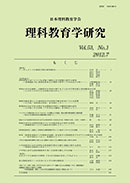Volume 44, Issue 2
Displaying 1-11 of 11 articles from this issue
- |<
- <
- 1
- >
- >|
Review Paper
-
2004Volume 44Issue 2 Pages 1-10
Published: January 15, 2004
Released on J-STAGE: June 30, 2022
Download PDF (1660K)
Original Papers
-
2004Volume 44Issue 2 Pages 11-26
Published: January 15, 2004
Released on J-STAGE: June 30, 2022
Download PDF (2419K) -
2004Volume 44Issue 2 Pages 27-34
Published: January 15, 2004
Released on J-STAGE: June 30, 2022
Download PDF (1140K) -
2004Volume 44Issue 2 Pages 35-46
Published: January 15, 2004
Released on J-STAGE: June 30, 2022
Download PDF (1900K) -
2004Volume 44Issue 2 Pages 47-58
Published: January 15, 2004
Released on J-STAGE: June 30, 2022
Download PDF (2037K) -
2004Volume 44Issue 2 Pages 59-70
Published: January 15, 2004
Released on J-STAGE: June 30, 2022
Download PDF (1942K) -
2004Volume 44Issue 2 Pages 71-81
Published: January 15, 2004
Released on J-STAGE: June 30, 2022
Download PDF (1583K) -
2004Volume 44Issue 2 Pages 83-94
Published: January 15, 2004
Released on J-STAGE: June 30, 2022
Download PDF (1583K)
Note
-
2004Volume 44Issue 2 Pages 95-100
Published: January 15, 2004
Released on J-STAGE: June 30, 2022
Download PDF (899K) -
2004Volume 44Issue 2 Pages 101-107
Published: January 15, 2004
Released on J-STAGE: June 30, 2022
Download PDF (975K) -
2004Volume 44Issue 2 Pages 109-122
Published: January 15, 2004
Released on J-STAGE: June 30, 2022
Download PDF (1671K)
- |<
- <
- 1
- >
- >|
